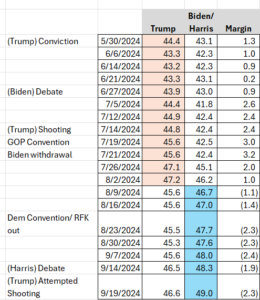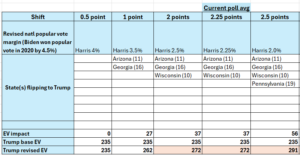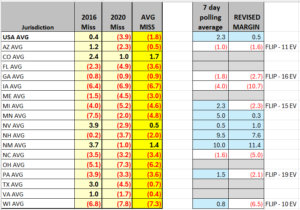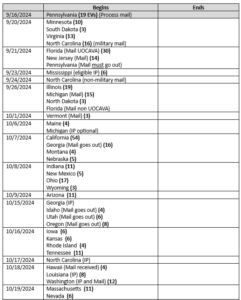Introduction
We are in the midst of election season (in fact, Election Day votes have already been cast in eight states), and primary season (except in Louisiana, which holds its primary at the same time as the federal election day of November 5) has concluded.
With the general election campaign (and “early voting season” underway), what has been going on (from a polling perspective) with the Presidential race?
Presidential Polling
When discussing polling for the 2024 Presidential contest, the main challenge that the party in power/Democratic nominee Kamala Harris faces is the fact that the Biden Administration remains unpopular (42-56% approval/disapproval according to a 7 day average of polls taken, which is a slight downgrade from 43-56% last week). Since Kamala Harris is Joe Biden’s Vice-President, that instant association with an unpopular President remains a negative weight on her campaign.
There has been a “back and forth” aspect to this campaign, although in today’s political climate, you don’t have substantial (i.e, more than 5%) shifts in either candidate’s polling. The Democrats have benefitted from both the Biden withdrawal on July 21 and, to a lesser extent, Kamala’s debate performance on September 10. Outside of those two events, it seems that an “equilibrium” has been reached with a Kamala Harris poll lead in the 2.0-2.5% range. As of this morning’s poll averaging, her lead is 2.3% (49.0-46.6%) over Donald Trump. For proper context, RealClearPolitics notes that at this point in time, Biden in 2020 was ahead of Trump by 6.5%, while Hillary Clinton was up 1.3% over Trump in 2016.
From a numerical/trend perspective, that means that a 3.2% Trump poll lead nine weeks ago has shifted 5.5% “to the left” to a 2.3% poll deficit. Despite initial (and limited/partial) polling after the debate showing that Harris had a 3.3% “debate poll bounce”, additional data showed that the bounce was notably less substantial. Which makes sense, because: (1) polarization in the American electorate allows for minimal partisan movement in either direction, and (2) short term spikes are therefore not having lasting impacts.
Below is a representation of the weekly changes in the national poll averages since late May:
Weekly Polling Averages
When discussing the news value of polls taken at a national level, it’s important (in terms of putting those polling numbers in their proper context) to realize that the Electoral College (and not the national popular vote) actually elects a President, and that marginally benefits the Republicans. In other words, because of an inefficient vote distribution of Democratic and Republican votes across the each state, it’s possible for a Republican to be elected President without attaining a popular vote majority (or even a plurality), because California and New York have in recent election cycles generated larger Democratic vote margins than Florida and Texas have for Republicans. And while large margins in California/New York can “run up the national popular vote score”, “running up the score” doesn’t get a Democratic candidate any closer to the needed 270 electoral votes without winning critical swing states.
National popular vote vs the Electoral College
To illustrate the disconnect between the Electoral College and the national popular vote, Joe Biden was elected in 2020 with a 4.5% popular vote margin (51.3-46.8%) over Donald Trump. He also “won” the Electoral College 303-235 using applicable numbers for the 2024 Presidential election (270 electoral votes are needed to win), Biden’s Electoral College victory was due to narrow victories in several states, like Arizona, Georgia, Michigan, Nevada, Pennsylvania, and Wisconsin.
From that starting point of a 4.5% national popular vote win, we can assess the extent to which shifts in the national popular vote towards Trump could flip specific swing states, as national shifts can and will have an impact in both swing and non-swing states. To be conservative in his analysis, JMC is assuming that only half of a national popular vote shift (percentage-wise) would occur in a swing state, since those states (which get an oversized amount of attention from either side) tend to be less elastic in their movement towards a candidate.
Still, even with this conservative analysis, any movement towards Trump relative to a 4.5% national popular vote deficit would “flip” states to Trump that narrowly voted for Biden in 2020. Even a Kamala Harris national popular vote win of 3.5% (a shift of only 1% towards Trump, in other words) would flip Arizona and Georgia, and those two flips alone would get Trump up to 262 electoral votes – 8 electoral votes shy of a victory. A Harris win of 2.5% (a 2% shift towards Trump relative to 2020) would then flip Wisconsin and get Trump to the necessary 270 electoral votes.
To translate that theory into “real world” terms, the last seven days of national polling show an average lead for Kamala Harris of 2.3% (she’s up 49.0-46.6% over Trump), which would translate to 272 electoral votes for Trump. In other words, a 2.3% Harris lead equals a 2.2% swing to Trump relative to his 2020 popular vote loss. A swing of that magnitude (even accounting for swing states’ inelasticity relative to the rest of the country) would flip Arizona, Georgia, and Wisconsin and give Trump the electoral votes he needs to win. Below is a representation of the electoral college impact of various national popular vote possibilities.
There is one more aspect to polling that needs to be discussed, and that is the calculation of polling error in swing states, as these errors in 2016 and 2020 almost without exception understated the Trump vote. If we were to examine how far the average of last week polls were “off”, and factor that error into the average of current polling over the last 7 days, what we find is that Trump can (based on current polling) flip Michigan and Pennsylvania, in addition to Arizona, Georgia, and Wisconsin. That would get him (under this hypothetical example, polling error is assumed not to have improved since 2016/2020) 306 electoral votes.
The early vote
While technically Election Day is November 5, an increasing number of voters are choosing to vote before that. Research done shows that 45% voted early in 2016, and that number surged to 69% in 2020. While the pandemic/mass adoption of mail voting certainly contributed to the increase in early voting in 2020, the reality is, Election Day voting has nevertheless become a thing of the past for an increasing number of people, which DOES impact the timing of when campaigns need to disseminate their messaging to voters.
In practical terms, “Election Day” would have begun when North Carolina was scheduled to send out mail ballots on September 6. However, the North Carolina Court of Appeals at the very last minute ordered that mail ballots due to be sent off instead be reprinted without Robert F. Kennedy, Jr’s name on them. The North Carolina Supreme Court concurred with the Appeals Court’s ruling, and as a result, military mail go out today, while non military mail ballots will go out September 24.
In the meantime, mail ballots have gone out in Pennsylvania and Wisconsin, and in person early voting will commence today in Minnesota, South Dakota, and Virginia. After that, more states will join in (both with mail and in person voting) as we advance through the election calendar, and by October 8, states constituting a majority of the Electoral College will have their “Election Days” underway. Below is a calendar of the next 30 days of early voting:
Early Voting Data
Even with the delayed launch in North Carolina, we DO have available data on mail ballot requests in 26 states, and currently, 47.9 million (up from 47.6M a week ago) are already requesting a mail in ballot. Furthermore, 1,009 ballots in eight states have already been turned in (compared to 77 a week ago). These figures will skyrocket with each passing week, especially since in person early voting has begin.
Conclusion
Even though the Republicans have had a rough time in the polls since the Biden withdrawal, the polling numbers have stabilized with a small Harris lead that is small enough to where it is possible for Donald Trump to amass 270 electoral votes.
Meanwhile, early voting is about to accelerate, which means in practical terms that the peak of campaign season (in terms of reaching the maximum number of movable voters) will actually be over the next two weeks, because states will be steadily ramping up their early voting throughout October, and by then, those who have voted become irrelevant to either campaign from either a persuasion or a turnout perspective.




